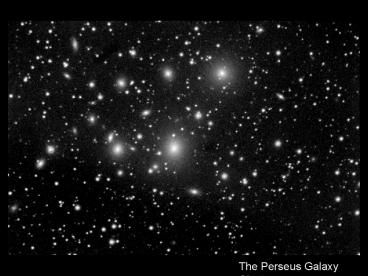The Perseus Galaxy Cluster
1 / 55
Title: The Perseus Galaxy Cluster
1
The Perseus Galaxy Cluster
2
(No Transcript)
3
M31 Andromeda
M87 Virgo
4
(No Transcript)
5
The Sombrero Galaxy Virgo
6
Handy Way to Weigh Spirals P
2pD/V (Pperiod, D distance from center, V
speed in orbit) MInside Orbit
D3/P2 (Pperiod, D distance from
center) MInside Orbit D3/(2pD/V)2 (1/4p)2 x
D x V2 So, MInside Orbit depends on V2 x D
7
(No Transcript)
8
M85 Coma Berenices
9
(No Transcript)
10
(No Transcript)
11
(No Transcript)
12
The Key to All of this (Masses, Diameters,
Luminosities) is Knowing DISTANCE
13
Standard Bulbs Cepheids L 100,000 LSun
Hubbles Discovery of Cepheids in M31 (Andromeda
Galaxy) 350 exposures (several hours long
each) 18 years to find 40 Cepheid Variables
14
Hubbles Discovery of Cepheids in M31 (Andromeda
Galaxy) 350 exposures (several hours long
each) 18 years to find 40 Cepheid Variables
15
Standard Bulbs Cepheids Have been found in 30
neaby galaxies
M100 65 million lyr
16
M100 65 million lyr
17
As we look at more and more distant galaxies, we
need more and more luminous standard bulbs...
18
Other Possible Standard Bulbs
19
Other Possible Standard Bulbs The Brightest
Stars in a Galaxy (65 mlyr) (wont work for
ellipticals - why?)
20
Other Possible Standard Bulbs The Brightest
Stars in a Galaxy (65 mlyr) (wont work for
ellipticals - why?) Size of Planetary Nebula
(70 mlyr)
21
Other Possible Standard Bulbs The Brightest
Stars in a Galaxy (65 mlyr) (wont work for
ellipticals - why?) Size of Planetary Nebula
(70 mlyr) Sizes of Globular Clusters (100 mlyr)
22
Other Possible Standard Bulbs The Brightest
Stars in a Galaxy (65 mlyr) (wont work for
ellipticals - why?) Size of Planetary Nebula
(70 mlyr) Sizes of Globular Clusters (100
mlyr) Type I Supernovae (8,000 mlyr! really good
- why?)
23
Type I Supernovae L 10,000,000,000 Lsun at peak
24
(No Transcript)
25
Other Possible Standard Bulbs The Brightest
Stars in a Galaxy (65 mlyr) (wont work for
ellipticals - why?) Size of Planetary Nebula
(70 mlyr) Sizes of Globular Clusters (100
mlyr) Type I Supernovae (8,000 mlyr! really good
- why?)
26
Other Possible Standard Bulbs The Brightest
Stars in a Galaxy (65 mlyr) (wont work for
ellipticals - why?) Size of Planetary Nebula
(70 mlyr) Sizes of Globular Clusters (100
mlyr) Type I Supernovae (8,000 mlyr! really good
- why?) The Brightest Galaxy in a Cluster
(13,000 mlyr)
27
The Perseus Galaxy Cluster
28
Other Possible Standard Bulbs The Brightest
Stars in a Galaxy (65 mlyr) (wont work for
ellipticals - why?) Size of Planetary Nebula
(70 mlyr) Sizes of Globular Clusters (100
mlyr) Type I Supernovae (8,000 mlyr! really good
- why?) The Brightest Galaxy in a Cluster
(13,000 mlyr)
29
(No Transcript)
30
Looking at Spirals Faster rotation - broader 21
cm H emission line Faster rotation - more
mass More mass - higher luminosity
31
Looking at Spirals Faster rotation - broader 21
cm H emission line Faster rotation - more
mass More mass - higher luminosity
Broader 21 cm H emission line - higher
luminosity Use with Apparent Brightness to get
Distance Tully-Fisher Method - good to 300
million lyr.
32
Will the Tully-Fisher Method work for
Ellipticals?
M85 Coma Berenices
33
(No Transcript)
34
1920s Hubble begins measuring distances to
galaxies (mostly using brightest star method)
35
1920s Hubble begins measuring distances to
galaxies (mostly using brightest star
method) 1912 Vesto Slipher begins taking
spectra of galaxies Star-like (absorption
lines) Very faint - 20/40 hour exposures!
20 years 40 galaxies Most are redshifted
(all but closest) Largest redshift 1,800
km/s
36
(No Transcript)
37
1920s Hubble begins measuring distances to
galaxies (mostly using brightest star
method) 1912 Vesto Slipher begins taking
spectra of galaxies Star-like (absorption
lines) Very faint - 20/40 hour exposures!
20 years 40 galaxies Most are redshifted
(all but closest) Largest redshift 1,800
km/s
38
1920s Hubble begins measuring distances to
galaxies (mostly using brightest star
method) 1912 Vesto Slipher begins taking
spectra of galaxies Star-like (absorption
lines) Very faint - 20/40 hour exposures!
20 years 40 galaxies Most are redshifted
(all but closest) Largest redshift 1,800
km/s Late 1920s Hubble plots his distances
versus Sliphers velocities
39
1929
40
1929
1931
41
1929
1931
Distance and Velocity (away) are related! V H x
D
42
A Handy Way to Get Distances to Far Away
Galaxies (if you know H) V H x D Measure V
from spectrum (redshift), Solve for D D
V/H Example V 40,000 km/s and H 20 km/s/Mlyr
43
(No Transcript)
44
(No Transcript)
45
(No Transcript)
46
Quiz 9 Groups of 3-4 WRITE NAMES CLEARLY
Just for fun, Dr. Briley assigns you a star in
the Milky Way to study. He tells you where it is
in the sky and nothing else, but you can make any
observation of it possible with today's
equipment. How would you figure out whether it
was a Population I and Population II star?
Discuss what observations you would make and how
that observation would help classify the
population type of the star. NOTE THERE ARE
MANY ANSWERS - GIVE AS MANY AS YOU CAN THINK OF!
47
(No Transcript)
48
(No Transcript)
49
(No Transcript)
50
(No Transcript)
51
(No Transcript)
52
(No Transcript)
53
(No Transcript)
54
(No Transcript)
55
Quiz 9
Just for fun, Dr. Briley assigns you a star in
the sky to study. He tells you where it is in the
sky and nothing else, but you can make any
observation of it possible with today's
equipment. How would you figure out whether it
was a Population I and Population II
object? Discuss what observations you would make
and how that observation would help classify the
population type of the star.































